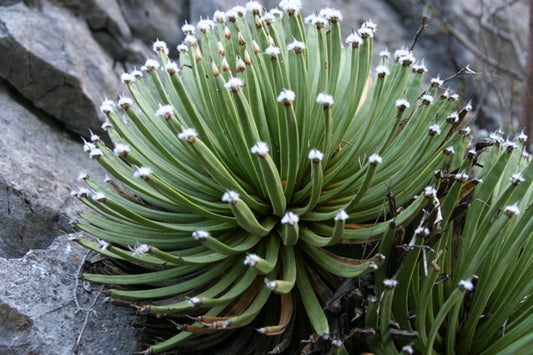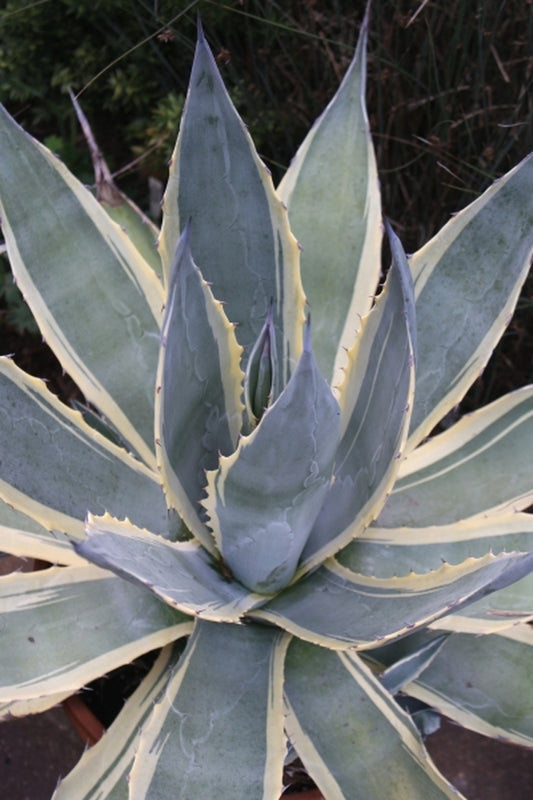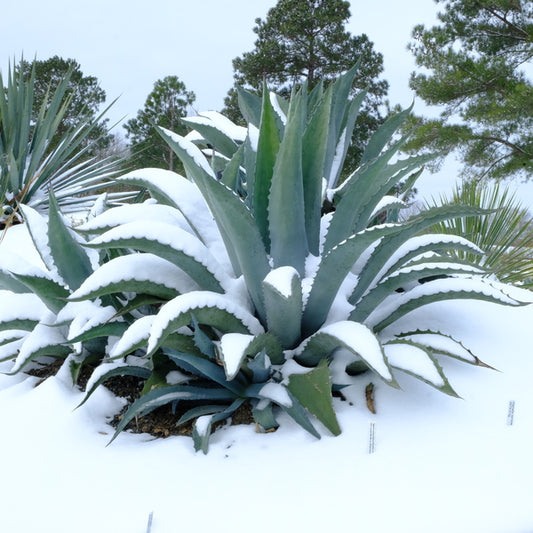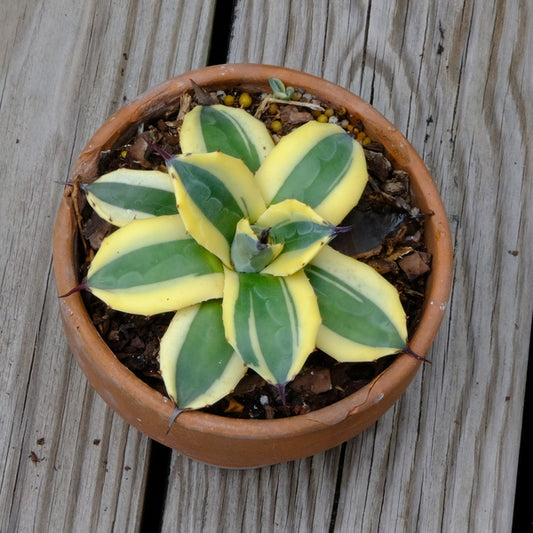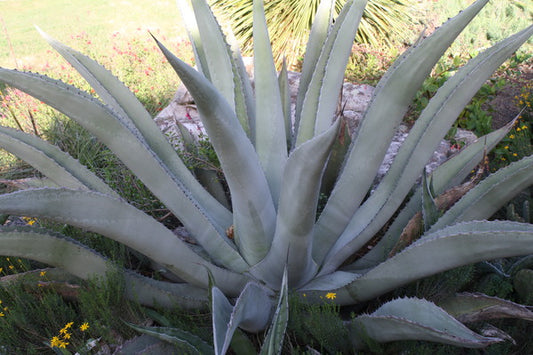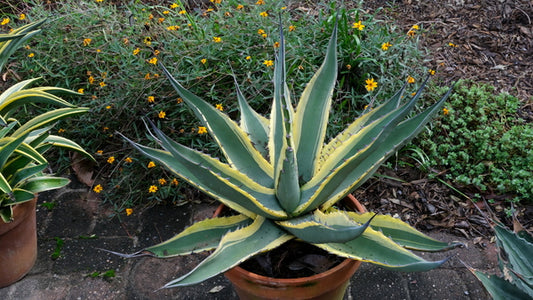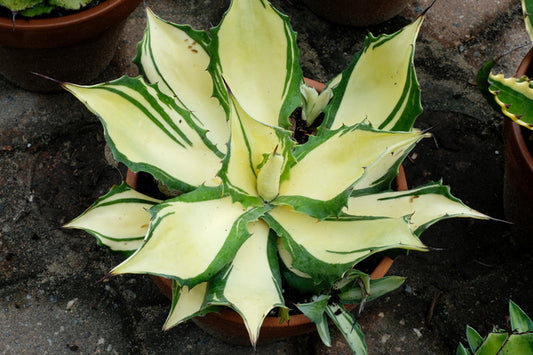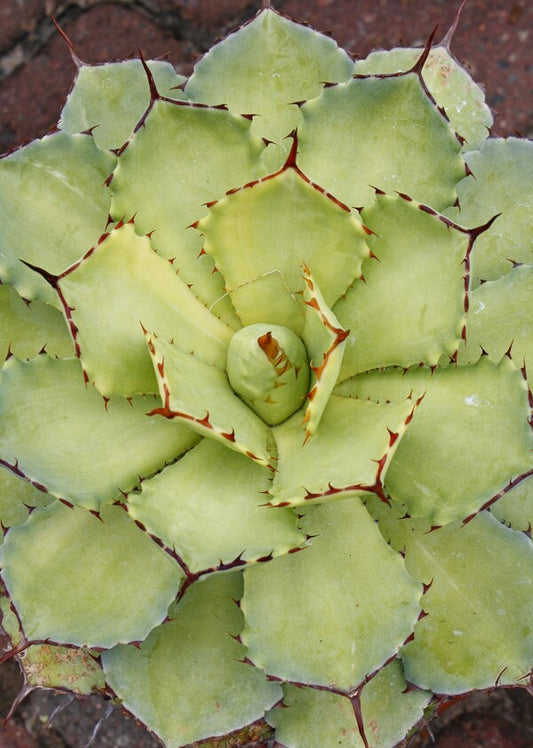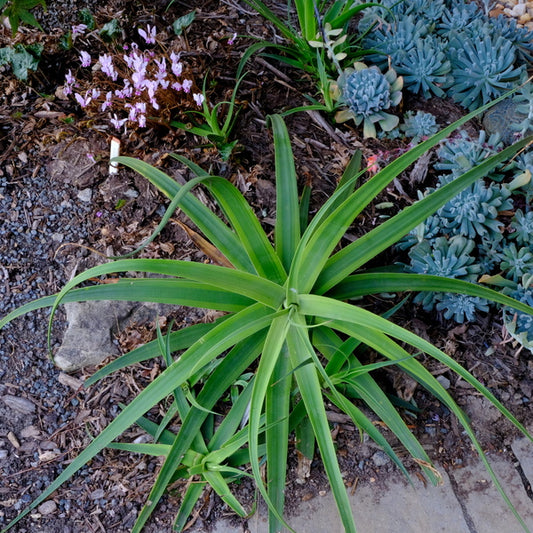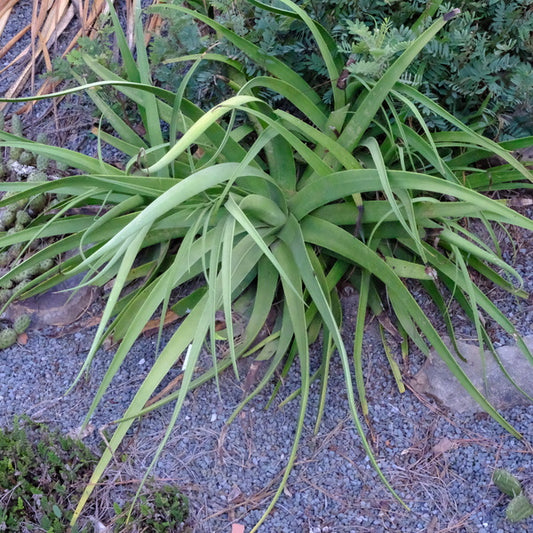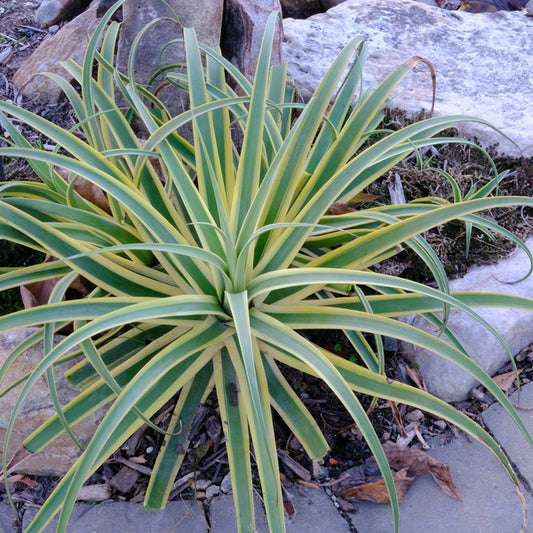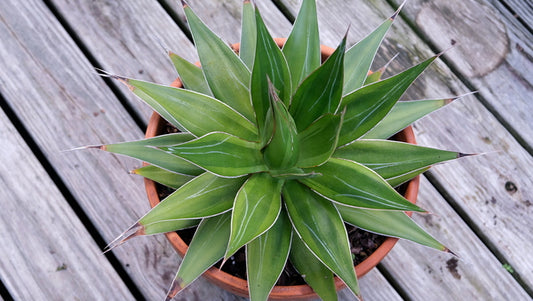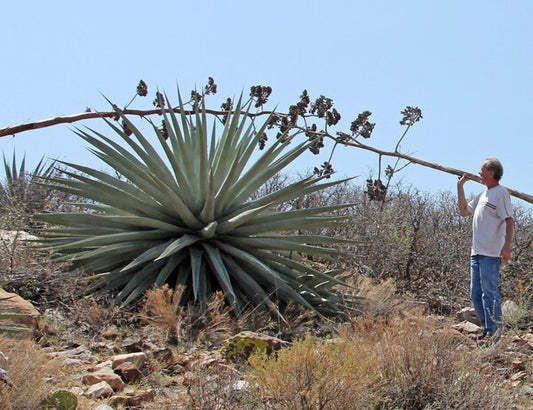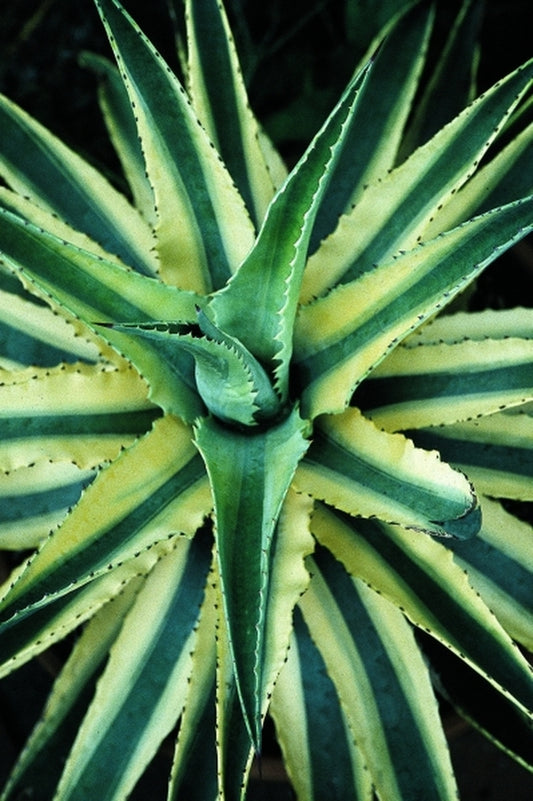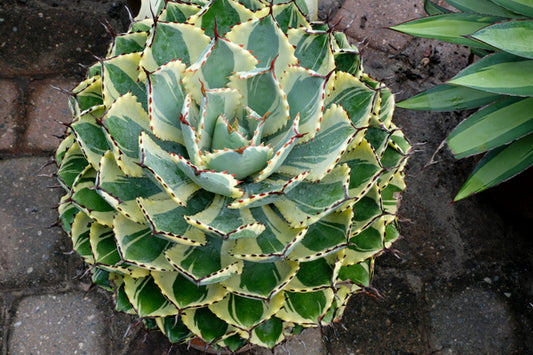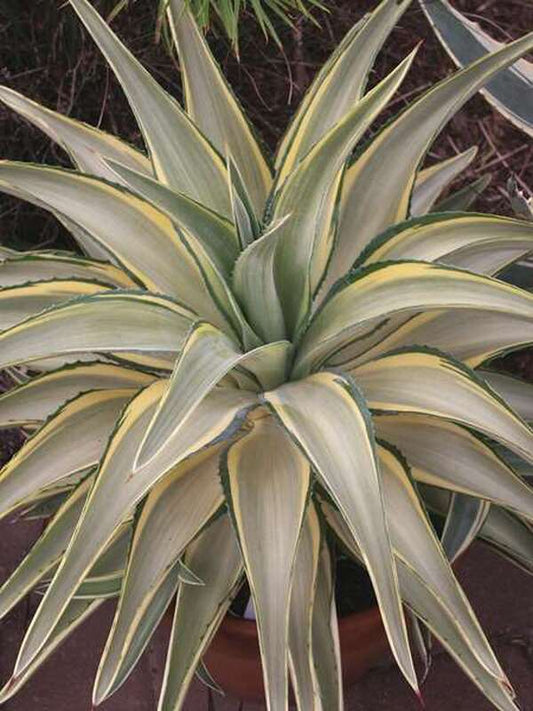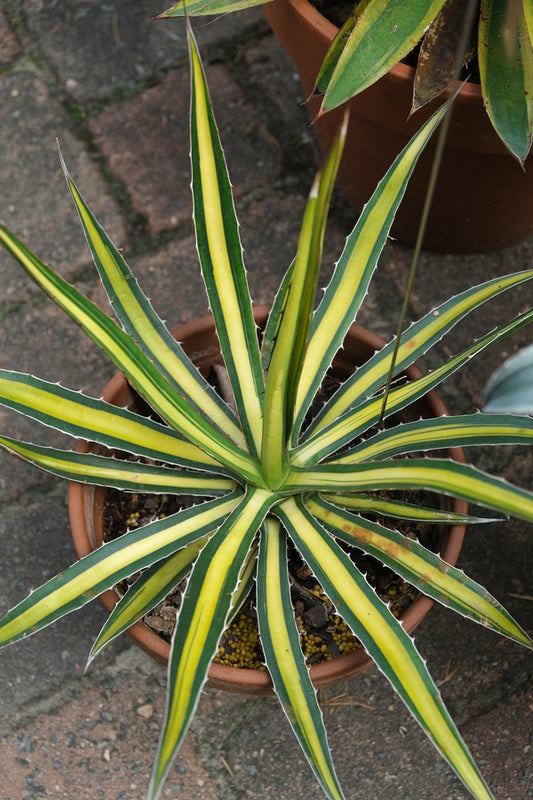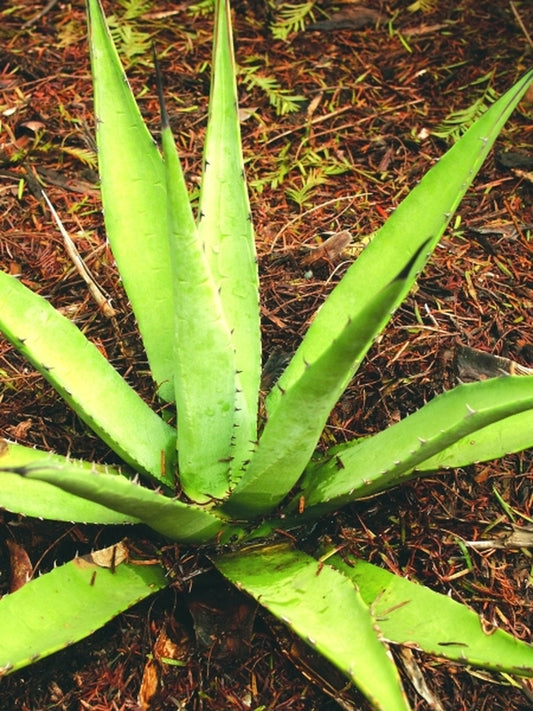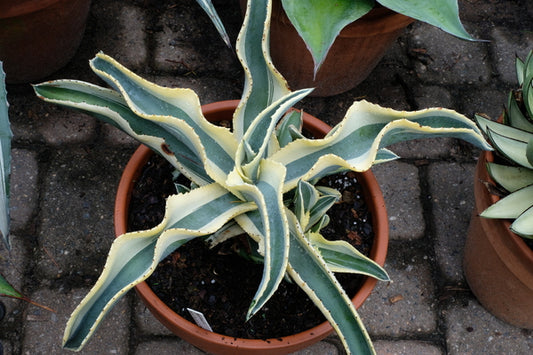Agave plants are exotic, deer-resistant, drought-tolerant plants with an amazing garden structure. Agave plants are called century plants since some species of this succulent genus take 100 years to flower in the wild. These plants are beautiful garden subjects and are also the source of the culinary agave nectar and tequila. Agaves are currently considered members of the asparagus family (Asparagaceae), and if you look closely at an unopened flower stalk, you’ll see why.
The foliage of most agaves is thick and succulent, due to their desert origins. Some of the more tropical species from wetter climates have leaves which are much thinner, reflecting this climatic difference. Agave foliage comes in green and blue to blue-silver. Even within a single batch of seed, offspring will display a wide range of subtle color variants from highly silver to blue green. Genetic mutations, known as chimeras, also occur in agaves. This leads to some rather dramatic variegated selections as has occurred with its woodland-loving sister genus, hosta. Once a particularly special trait has been discovered in an agave, it is named and then propagated asexually (without pollination). This ensures that each plant with that clonal name, identified by ‘single quotes’, will be identical.
The agave plants we sell are propagated from the photographed mature specimens, so please be patient. Learn more about growing agaves in the Southeastern US.
-
Agave albopilosa
Item #: 9610
Zones: 8a to 10b, guessing
Dormancy: Evergreen
Height: 12" tall
Culture: Sun to Part Sun
Origin: Mexico
Pot Size: 3.5" pot (24 fl. oz/0.7 L)
Regular price $70.00Regular priceUnit price per -
Agave americana 'Marshmallow Cream'
Item #: 7869
Zones: 9a to 10b, guessing
Dormancy: Evergreen
Height: 60" tall
Culture: Sun
Origin: Mexico
Pot Size: 3.5" pot (24 fl. oz/0.7 L)
Regular price $35.00Regular priceUnit price per -
Agave x amourifolia 'Twisted Tongue'
Item #: 13065
Zones: 7b to 10b, at least
Dormancy: Evergreen
Height: 36" tall
Culture: Sun
Origin: Hybrid
Pot Size: 3.5" pot (24 fl. oz/0.7 L)
Regular price $39.00Regular priceUnit price per -
Agave applanata 'Butter Cream'
Item #: 13072
Zones: 9a to 10b
Dormancy: Evergreen
Height: 3" tall
Culture: Sun
Origin: Mexico
Pot Size: 3.5" pot (24 fl. oz/0.7 L)
Regular price $100.00Regular priceUnit price per -
Agave applanata 'Cream Spike'
Item #: 7241
Zones: 9a to 10b
Dormancy: Evergreen
Height: 10" tall
Culture: Sun
Origin: Mexico
Pot Size: 3.5" pot (24 fl. oz/0.7 L)
Regular price $33.00Regular priceUnit price per -
Agave asperrima
Item #: 6327
Zones: 7b to 10b
Dormancy: Evergreen
Height: 36" tall
Culture: Sun
Origin: Mexico, United States
Pot Size: 3.5" pot (24 fl. oz/0.7 L)
Regular price $30.00Regular priceUnit price per -
Agave asperrima ssp. maderensis 'Grand Duke'
Item #: 12313
Zones: 9a to 10b, possibly colder
Dormancy: Evergreen
Height: 18" tall
Culture: Sun to Part Sun
Origin: Mexico
Pot Size: 3.5" pot (24 fl. oz/0.7 L)
Regular price $38.00Regular priceUnit price per -
Agave 'Bareback Rider'
Item #: 12082
Zones: 9b to Tropical
Dormancy: Evergreen
Height: 12" tall
Culture: Sun to Part Sun
Origin: Hybrid
Pot Size: 3.5" pot (24 fl. oz/0.7 L)
Regular price $250.00Regular priceUnit price per -
Agave 'Bleached Blonde'
Item #: 9347
Zones: 9a to 10b
Dormancy: Evergreen
Height: 12" tall
Culture: Sun to Part Sun
Origin: Mexico
Pot Size: 3.5" pot (24 fl. oz/0.7 L)
Regular price $39.00Regular priceUnit price per -
Agave bovicornuta 'Divine Bovine'
Item #: 11391
Zones: 9a to 11
Dormancy: Evergreen
Height: 24" tall
Culture: Sun to Part Sun
Origin: Mexico
Pot Size: 3.5" pot (24 fl. oz/0.7 L)
Regular price $100.00Regular priceUnit price per -
Agave bracteosa 'Daddy Longlegs'
Item #: 1922
Zones: 7b to 10b
Dormancy: Evergreen
Height: 18" tall
Culture: Sun to Part Sun
Origin: Mexico
Pot Size: 3.5" pot (24 fl. oz/0.7 L)
Regular price $45.00Regular priceUnit price per -
Agave bracteosa 'Octopussy'
Item #: 8539
Zones: 7b to 10b
Dormancy: Evergreen
Height: 12" tall
Culture: Sun to Part Sun
Origin: Mexico
Pot Size: 3.5" pot (24 fl. oz/0.7 L)
Regular price $38.00Regular priceUnit price per -
Agave bracteosa 'Stingray' PP 30,280
Item #: 2167
Zones: 7b to 10b, possibly colder
Dormancy: Evergreen
Height: 18" tall
Culture: Part Sun
Origin: Mexico
Pot Size: 3.5" pot (24 fl. oz/0.7 L)
Regular price $42.00Regular priceUnit price per -
Agave chazaroi 'Lasting Impressions'
Item #: 16480
Zones: 9b to 11
Dormancy: Evergreen
Height: 30" tall
Culture: Sun to Part Sun
Origin: Mexico
Pot Size: 3.5" pot (24 fl. oz/0.7 L)
Regular price $39.00Regular priceUnit price per -
Agave chrysantha 'Pinal Giants'
Item #: 16578
Zones: 8b to 10a, guessing
Dormancy: Evergreen
Height: 96" tall
Culture: Sun
Origin: United States
Pot Size: 3.5" pot (24 fl. oz/0.7 L)
Regular price $39.00Regular priceUnit price per -
Agave 'Cornelius'
Item #: 6289
Zones: 9a to 10b, at least
Dormancy: Evergreen
Height: 18" tall
Culture: Sun
Origin: Hybrid
Pot Size: 3.5" pot (24 fl. oz/0.7 L)
Regular price $35.00Regular priceUnit price per -
Agave cundinamarcensis 'Condor'
Item #: 9822
Zones: Tropical
Dormancy: Evergreen
Height: 72" tall
Culture: Sun to Part Sun
Origin: Colombia
Pot Size: 3.5" pot (24 fl. oz/0.7 L)
Regular price $50.00Regular priceUnit price per -
Agave 'Desert Diamond' PP 26,384
Item #: 9457
Zones: 9a to 10b
Dormancy: Evergreen
Height: 15" tall
Culture: Sun
Origin: Mexico
Pot Size: 3.5" pot (24 fl. oz/0.7 L)
Regular price $39.00Regular priceUnit price per -
Agave 'Desert Love'
Item #: 12743
Zones: 7a to 9b, at least
Dormancy: Evergreen
Height: 24" tall
Culture: Sun
Origin: Hybrid
Pot Size: 3.5" pot (24 fl. oz/0.7 L)
Regular price $36.00Regular priceUnit price per -
Agave desmettiana 'Joe Hoak'
Item #: 7137
Zones: Tropical
Dormancy: Evergreen
Height: 36" tall
Culture: Sun to Part Sun
Origin: Unknown
Pot Size: 3.5" pot (24 fl. oz/0.7 L)
Regular price $34.00Regular priceUnit price per -
Agave funkiana 'Olympic Gold'
Item #: 11768
Zones: 9a to Tropical
Dormancy: Evergreen
Height: 12" tall
Culture: Sun to Part Sun
Origin: Mexico
Pot Size: 3.5" pot (24 fl. oz/0.7 L)
Regular price $50.00Regular priceUnit price per -
Agave x gracilipes
Item #: 6562
Zones: 6a to 9b, possibly colder
Dormancy: Evergreen
Height: 12" tall
Culture: Sun
Origin: United States
Pot Size: 3.5" pot (24 fl. oz/0.7 L)
Regular price $34.00Regular priceUnit price per -
Agave gypsophila ssp. gypsophila 'Zingara'
Item #: 16024
Zones: Tropical
Dormancy: Evergreen
Height: 20" tall
Culture: Sun
Origin: Mexico
Pot Size: 3.5" pot (24 fl. oz/0.7 L)
Regular price $38.00Regular priceUnit price per -
Agave gypsophila ssp. pablocarrilloi 'Blue Ivory' PP 32,370
Item #: 14786
Zones: Tropical
Dormancy: Evergreen
Height: 7" tall
Culture: Sun
Origin: Mexico
Pot Size: 3.5" pot (24 fl. oz/0.7 L)
Regular price $38.00Regular priceUnit price per
More Information About Agave
While most people are interested in agave plants for the sweetener called agave nectar or for its use in making tequila, we love agave for its ornamental value over its culinary or medicinal value. Nonetheless, we think agave is a very 'sweet' plant...in the garden.
In cultivation with adequate summer moisture, most agaves flower between 10 and 15 years of age and when they do flower, the tall bloom stalks attract hummingbirds. Agaves are mainly natives of the Southwest US and Mexico.
Cold Hardy Agave
The colder region in which you garden, the less agave choices you will have for in ground use. The most cold tolerant agave species are Agave utahensis, Agave mckelveyana, and northern forms of Agave parryi. While these are very winter hardy, they are also very intolerant of excessive summer and winter moisture. The next most winter hardy species include Agave parryi (middle elevation forms), Agave ovatifolia, Agave bracteosa, Agave havardiana, Agave striata, Agave lophantha, Agave lechuguilla, Agave montana, Agave gentryi, Agave ocahui, Agave multifilifera, Agave parviflora, Agave victoriae-reginae, and Agave difformis. Even with winter hardy agave species, each clone may also vary somewhat in its winter temperature tolerances. It is the hybrids between winter hardy agave species that allow list of growable options to expand dramatically.
For those looking for large hardy agaves, your best choices are Agave ovatifolia, Agave americana (only if you live in Zone 9a and south), Agave x protamericana, of which some clones can survive in Zone 7b, and the mysterious Agave x pseudoferox, which is often sold as a hardy form of Agave salmiana var. ferox. We have a number of our own large hybrids that we hope to one day add to this list once in-ground trials are complete.
For gardeners with space or lifestyle considerations, agaves make great container specimens. Unlike some plants, agaves will grow to their container size and remain there, albeit somewhat grudgingly. If you have room to let your containerized agaves grow larger, keep in mind that they love moisture and nutrition in the growing season, but only if they are kept in bright sun with good air circulation. Surprisingly, container agaves are actually tolerant of waterlogged soils in the summer when growth is fastest, but they are not fond of sprinklers, which keep their dry-loving foliage too wet. If you’re heading out on vacation, fill a pot saucer with water and your agave will be fine for 2-4 weeks with no attention.
Just remember that potted agaves must be brought indoors when winter temperatures get too cold. Zone 9/10 agaves should be brought indoors before temperature drop into the mid-30s F (2 C). Zone 8 plants are fine down to the mid-20s F (-4 C). Zone 7 and colder plants should be fine until the temperature hits 20 F (-6 C), but no colder.
How to Grow Agave in the Garden
In the summer months, agaves in the ground also respond amazingly to water and organic fertilizer but in the winter, good drainage on a sloped site is essential for agave survival. In cold zones, we recommend establishing agave plants early in the growing season (by midsummer at the latest) for best results. We also recommend planting a shrub on the north side of an agave, which helps to remove excess moisture from the soil, without providing shade. Agaves are also salt tolerant plants, good for coastal gardens. Select carefully when planting your new agave, because some can get quite large...i.e., Agave salmiana and Agave protoamericana, which can grow to be 8-12 feet (2.4-3.6 meters) wide.
We are pleased to offer an increasing number of rare, variegated agaves for sale that until recently have been confined to the high-dollar collectors' market. When you are ready to buy agaves for your garden or containers, we hope you will check out our list of succulent agaves for sale.
Check out our many blog posts about agaves.
Don't forget to check out our Agave photo gallery of our personal agave collection...one of the largest private agave collections in the world.
Trivia: The agave nectar that is so popular right now is not, as the name implies, a product of the agave flower. Instead, agave nectar is made from sap pressed from the central core of the agave plant (the piña) or the flower stalks. This pre-agave nectar is called 'aguamiel' and it is processed into agave nectar syrup. It is this same syrup that is brewed into the beer-like drink pulque and further distilled into tequila or mezcal.
Check Out These Agave Videos


